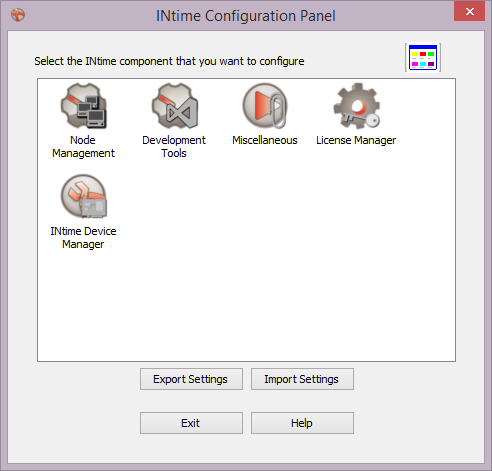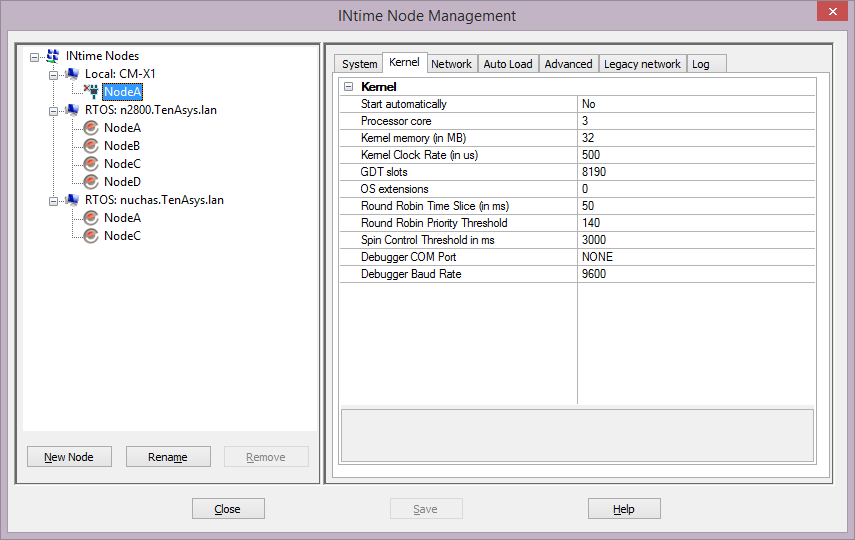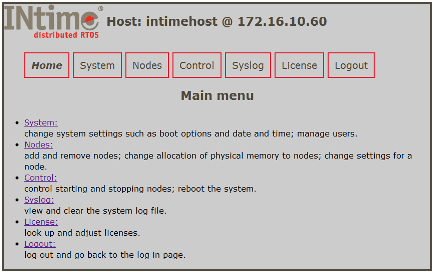

INtime is a complex product. There are many parameters to configure which allow a large variety of different solutions using the product. This section describes the configuration process in detail.
The process is different for each product. INtime for Windows and the INtime SDK have a Control Panel application for managing the configuration. INtime Distributed has a web-based interface to configure the target system.
By default, the Install program configures INtime software to:
%PROGRAMFILES%\INtime directory.
The INtime Configuration utility's Help contains step-by-step instructions for many tasks. You can access this Help by running the utility, then pressing the Help button located at the bottom of the window.
Configuration of an INtime for Windows System is done with help of the INtime configuration Panel, a Windows-based utility that is installed with the product.
To enter the Configuration utility, either:
The following dialog is displayed:

The following utilities are available:
| Utility | Function |
| Node Management | Configure local nodes: create and configure local INtime for Windows nodes Configure system settings: Access Distributed RTOS nodes for configuration and file transfer |
| Development Tools | Install INtime components into Visual Studio |
| Miscellaneous | Configure certain system features |
|
License Manager |
Check existing license status, and install new licenses |
| INtime Device Manager | Configure I/O devices to be controlled by INtime instead of Windows |
This applet allows individual local INtime nodes to be configured, and INtime for Windows system parameters to be modified. It also provides access to the configuration interface for INtime Distributed RTOS nodes.
Left-hand pane:
Display of active local and RTOS nodes. Local nodes have a simple node name. RTOS nodes are preceded by the hostname where they reside.
Selecting the local host name allows the configuration of INtime for Windows system parameters.
Selecting an individual local node name allows that node to be configured.
Selecting an RTOS node name provide links to the configuration application on that node. It also allows the setting up of a local FTP client to transfer files to and from the node.
INtime for Windows System parameters
The System tab is displayed when the local host name is selected in the left-hand pane, or when one of the local nodes is selected.
These settings configure the whole Windows platform to set up the environment in which INtime runs.
Windows interaction
The two most important items in this table are as follows:
Boot mode: the default configuration for 32-bit systems (before Windows 8) is for Windows and a single INtime node to share a CPU thread. All other available threads are used by Windows. This mode is called "Shared mode". On 64-bit Windows systems, and all systems from Windows 8 forwards, the INtime node is assigned to its own core, or hardware thread. This mode is called "Dedicated mode". A 32-bit Windows system can also be configured for Dedicated mode using the "Boot mode" setting.
Memory allocation: The default method to allocate memory to the INtime system is to use Windows Non-Paged Pool. If your system does not have enough memory to do this, or you wish to allocate a large amount of memory to INtime on a 32-bit system, change the memory allocation method to "Exclude memory from Windows". This configures the Windows boot-loader to remove memory from the system RAM and not to use it for Windows. This memory is then used by INtime for node memory.
Warning: If you use the "Exclude memory from Windows" setting, and you change the amount of RAM installed in your system, you need to recalibrate the memory removed from Windows by clicking the "Redetect Physical Memory" button in this panel. Not doing this can cause the system to fail to boot.
You may also need to do this if you change your video card, or its memory configuration.
Other items in this table are described in detail in the Configuration help file.
The Kernel tab is used to configure kernel settings specific to this node, such as the amount of memory allocated to the node and the system clock rate.
The Network tab is used to configure the network stack for the selected node, including the selection of drivers and IPv4 and IPv6 address selection.
The Auto Load tab is used to configure the automatic startup real-time applications as well as system services such as iWin32 and the SpinDoctor.
The Advanced tab is used to configure all the possible settings for the node software. This should only be used in unusual circumstances on advice from TenAsys support staff.
The Legacy Network tab is used to configure the legacy networking software. This should only be used if you have applications generated from version of INtime prior to version 4.0, and you need to keep binary compatibility. Newer applications should use the current network implementation.
The Log tab shows the log messages captured from certain parts of the configuration process. In some cases you may be asked to report the contents of this tab by TenAsys support staff.
This applet allows you to install or uninstall support for different versions of Visual Studio. You should only normally need to use this if you installed Visual Studio after you installed the INtime SDK.
Certain settings do not easily fit into other applets. This includes settings such as setting the size and behavior of INtime console windows, and the default behavior of the Fault Manager.
This applet allows you to install and manage your licenses. The license management process is described in a separate document and depends on which version of the product you purchased.
The INtime Device Manager passes control of a plug-and-play device between Windows and a local INtime node. Since Windows gets control when the PC boots, it looks for new hardware and installs associated device drivers as necessary. This may be undesired when a device must be controlled by an INtime process. This utility assigns a device to INtime use by installing a simple device driver on the requested device. The device driver does two things:
See the utility's help file for detailed instructions.
INtime Distributed RTOS is configured by a different, web-based utility located on the target host. It is accessed from any browser.
If you do not know the IP address of the target node you can use the INtime Configuration utility on the INtime SDK to connect you:
Open the Node Management applet in the Configuration utility.

Select your node in the "Dynamic Nodes" section in the left-hand panel. The right-hand panel shows the IP address of your node and gives you the option "Configure over Internet". Click that button to open your default browser pointing to the host's web server.
You will now be prompted to log in to the web configuration utility. If you did not configure a password during installation of the target host just press the Login button.

Configuration setups can be accessed by clicking on the buttons across the top of the screen or by clicking the highlighted header in the outline.
This screen allows you to add, edit or remove a node, and it shows the memory allocated to each configured node, as well as the CPU cores available on which to create new nodes.
This screen shows kernel parameters which may be updated, including the node name. More details about the configuration of the network, initial application loader and advanced settings is available via the links at the bottom of the page.
This screen allows you to start and stop the application nodes (not the boot, or first node), or to restart the system.
This screen allows you to assign PCI devices to a dedivated node.
Syslog message from applications and system utilities are captured here.
This screen allows you to activate the system by applying a license. See the separate license documentation for full details.
Log out of the configuration utility.